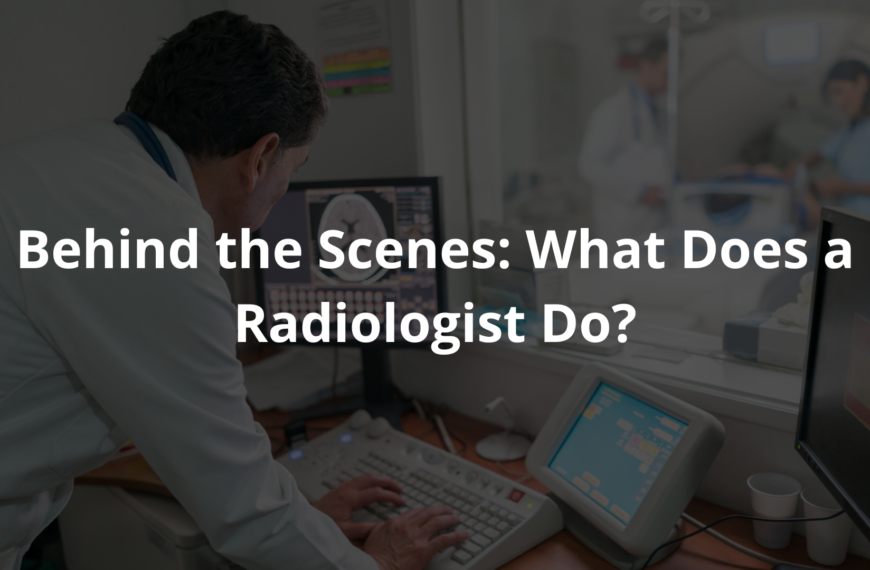Learn how consultation with radiologists in Australia helps patients get expert advice and improved health outcomes.
Radiologists play a key role in understanding what’s happening inside the human body. They’re the experts who interpret images from machines like MRIs, CT scans, and X-rays. These pictures aren’t just random snapshots—they’re detailed maps that help doctors figure out what’s going on, whether it’s a broken bone, a tumour, or something less obvious.
It’s almost like solving a puzzle, with each image being a piece. And while the machines do the scanning, it’s the radiologists who make sense of it all. Curious about how these images guide life-changing decisions? Keep reading to explore the fascinating world of medical imaging!
Key Takeaway
- Radiologists use special machines to help doctors diagnose diseases.
- You usually need a referral from your GP to see a radiologist.
- Many imaging services are covered by Medicare, meaning lower costs for patients.
The Role of Radiologists
Radiologists are doctors with a unique job—they look at pictures of the inside of our bodies to figure out if something’s wrong. They use tools like X-rays, MRIs, and CT scans (which stands for computed tomography). Each of these tools is good for spotting different kinds of problems.
- Diagnostic Radiologists: These are the ones who focus on finding out what’s going on. They study the images closely, looking for signs of illness or injury.
- Interventional Radiologists: These specialists don’t just look at pictures—they also perform small procedures. They use imaging to guide them while they work, which helps lower risks for the patient.
- Therapeutic Radiologists: These doctors use radiation to treat diseases like cancer. Their goal is to target cancer cells while keeping healthy parts of the body safe.
Radiologists are a big part of healthcare. They help doctors figure out what’s wrong and even help treat it. [1]
How to See a Radiologist
If someone needs to see a radiologist, the first step is usually getting a referral from their GP (general practitioner). A referral is a note that explains why the patient needs imaging and what kind might help.
Referrals matter because they give the radiologist important details about the patient’s health. It’s not just about booking an appointment—it’s about making sure the radiologist knows what to look for.
These days, referrals can also be done online. Apps and websites like Our Sage and Instant Consult make it easier to get one without visiting the GP in person. This can save time and make the process smoother for patients.
Services Offered by Radiologists
Radiologists offer a range of services to help patients. Here’s what they do:
- They figure out which imaging test is best for the patient’s problem. This might involve asking about symptoms or looking at medical history.
- Once the images are taken, they study them carefully and write a report. These reports go back to the GP, who explains the results to the patient.
- Radiologists can also do procedures like biopsies. A biopsy is when they take a tiny piece of tissue to check for disease, which is often key for diagnosing conditions like cancer.
- They work closely with other doctors and healthcare teams to make sure the patient’s care is well-coordinated. This teamwork helps ensure the best possible treatment.
Radiologists are committed to helping patients by using their skills and tools to diagnose and treat health issues.
Accessing Radiology Services
Getting access to radiology services isn’t too complicated. Most of the time, it starts with a referral from a GP (general practitioner). This is the usual way—your GP decides you need imaging, like an X-ray or MRI, and sends you to a radiologist. It’s straightforward and probably the most common method.
Now, there’s also the option of using online platforms. These days, technology’s made things easier. Platforms like Our Sage let doctors send digital referrals, which can save patients a trip to the clinic just to get a piece of paper. It’s quicker and, honestly, more convenient for a lot of people. [2]
Costs for radiology services depend on a few things, like the type of imaging you need and where you go. But the good news is that Medicare covers many of these services, which takes some of the financial pressure off. Still, it’s smart to double-check with your health fund or insurance to know what’s covered and what isn’t. No one likes surprise bills.
Benefits of Consultation with Radiologists
Talking with a radiologist can really make a difference. These specialists are trained to spot things that might be missed otherwise, like early signs of breast cancer or heart issues. They’ve got this knack for picking up on details in imaging that others might overlook.
Sometimes, getting a second opinion from a radiologist can help ease a patient’s mind. If there’s any doubt about a diagnosis, hearing from someone who’s an expert in reading scans can be reassuring.
Radiologists work hard to make sure their findings are clear. They don’t just look at the scans—they write detailed reports that explain what they see. These reports go back to the referring doctor, so everyone involved in the patient’s care knows what’s going on. It’s all about teamwork, really.
Patients can trust that radiologists are trained to be thorough. They’re looking for even the tiniest clues that could help figure out what’s wrong.
RANZCR and Standards
The Royal Australian and New Zealand College of Radiologists (RANZCR) is the group that keeps radiology practices in check. They set the rules, making sure radiologists stick to high standards.
These rules cover everything from how to write reports to how radiologists should communicate with other doctors. And they don’t just make the rules and forget about them. The RANZCR updates their guidelines regularly to keep up with new research and methods. [3]
For example, back in 2018, they made some updates to reflect the latest findings. This shows they’re serious about staying current. Radiologists are always learning and improving, which is good news for patients. It means the care they get is based on the most up-to-date information.
What Happens During a Consultation?
When someone visits a radiologist, the appointment usually begins with a chat about their health history. The radiologist might ask about any symptoms they’ve been feeling, concerns they have, or tests they’ve had before. This helps the radiologist figure out what’s going on and what the patient might need.
After that, the radiologist might do an imaging test. This could be something like an MRI, a CT scan, or another type of scan, depending on what’s needed. Once the test is done, the radiologist takes a close look at the images to understand what they show.
When they’ve finished reviewing the images, the radiologist writes up a report. This report explains what they’ve found and is sent to the patient’s GP (general practitioner). The GP then talks with the patient about the results. This way, the patient gets a clear picture of their health and the next steps they might need to take.
Preparing for Your Visit
Getting ready for a visit to the radiologist can make things easier. Here are a few tips to help:
- Bring Medical Records: It’s a good idea to bring along any medical records or past imaging results. These can give the radiologist more information to work with.
- List of Medications: Write down all the medications you’re currently taking. This helps the radiologist know if there’s anything they should watch out for.
- Medicare Card: Don’t forget your Medicare card. It’s often needed for billing or insurance purposes.
Having these things sorted out before the appointment can save time and help the radiologist focus on providing the best care.
Costs and Medicare Coverage

A lot of radiology consultations are bulk-billed, which means patients don’t have to pay upfront. This can be a big help for many people, making healthcare less stressful and more affordable.
That said, there might be some costs for certain procedures that Medicare doesn’t cover. It’s a good idea to check with the radiology office beforehand to find out if there’ll be any charges. Knowing this ahead of time can help avoid surprises.
It’s also smart to know your health insurance details. This can help you figure out what’s covered and what you might need to pay yourself.
If you’re feeling unsure about anything, don’t hesitate to ask questions. Radiologists and their staff are there to help, and being prepared can make the whole process smoother for everyone.
FAQ
How can I ensure my radiology consultation is bulk billed through Medicare benefits schedule?
Many medical practitioners offer bulk billed imaging services through Medicare. Check with the radiology departments about bulk billing options before booking. Keep in mind that benefits are not payable for some specialized services like cardiac imaging or nuclear medicine. The medicare benefits schedule covers most basic diagnostic imaging, but always verify coverage beforehand.
What should I expect during a radiology consultation service at a university hospital?
During your consultation at academic medical center radiology departments, specialist radiologists will review your imaging studies and provide professional attendance. They’ll walk you through the imaging report and assist in clinical decision making. Patient care and patient satisfaction are top priorities, ensuring you understand your diagnostic imaging results.
How do specialists at the Royal Australian and New Zealand College of Radiologists handle consultation services?
These specialist radiologists provide comprehensive diagnostic and interventional services. They offer expertise in various areas including computed tomography, magnetic resonance imaging, and clinical radiology. The consultation includes thorough imaging studies review and second opinion services when needed.
What role does diagnostic radiology play in breast cancer detection and treatment?
Diagnostic imaging is crucial for breast cancer screening and treatment planning. Department of radiology teams use various imaging services including MRI services to support decision making. They work closely with medical practitioners to ensure accurate diagnosis and treatment planning through radiology consultation services.
Can I find credible radiology consultation research on platforms like Google Scholar?
Yes, researchers like Gunn AJ, Sahani DV, and Mangano MD frequently publish on imaging services. Group I3 and other research teams at based radiology centers regularly contribute to medical imaging literature. You can access studies about interventional radiology, cardiac CT, and other diagnostic procedures through academic databases.
How can I check my MBS online for radiology consultation coverage?
The MBS online platform lets you verify which diagnostic imaging procedures are covered. You can check specific medical imaging services and see which consultation services qualify for medicare benefits. This is particularly useful when planning visits to specialist radiologists or seeking interventional procedures.
Conclusion
Radiology consultations are an essential part of healthcare in Australia. They help doctors figure out what’s going on inside the body and choose the right treatment. With advancing technology and updated guidelines, accessing care has become simpler. If you think you might need a radiology consultation, have a chat with your GP. They’ll guide you on the next steps to take for your health. It’s all about working together for better outcomes.
References
- https://www.betterhealth.vic.gov.au/health/serviceprofiles/Radiologist
- https://www.oursage.com.au/radiology-referral-online
- https://pubmed.ncbi.nlm.nih.gov/30019848/




